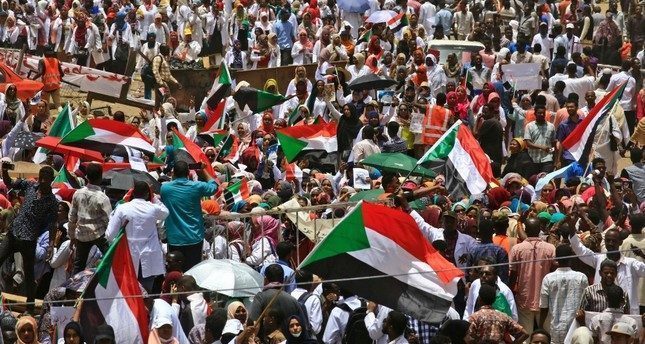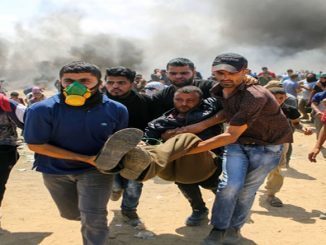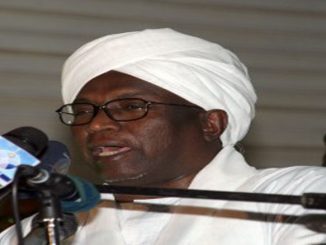
One year after protests broke out in Sudan over soaring bread prices, celebrations are planned across the country today to mark the uprising that brought down Omar Al-Bashir.
A year ago, on 19 December 2018, the image of the gutted offices of Sudan’s ruling party in Atbara spread like wildfire through social media, feeding public anger over the rising cost of living, igniting far deeper grievances against President Omar al-Bashir and his 30-year rule.
Protests spread through that night, and in the days and weeks that followed, until Bashir finally stepped down on 11 April.
The past year has been a historical one for Sudan, long stifled by corruption and sanctions and torn apart by the government’s many wars, as many Sudanese hope 2020 will mark a transition towards a civilian government.
In late 2018, austerity was biting. Queues for bread and fuel were long and prices were high. Sudan’s economy had been crippled since the loss of oil wealth with South Sudan’s independence in 2011 – and the Bashir government’s response was budget cut after budget cut stripping away at the country’s social safety nets – including key commodity subsidies – while military spending remained high.
By December 2018, as bread prices suddenly tripled, young protesters – mostly school-age students – spontaneously took to the streets. Such outbursts were quickly snuffed out by heavily deployed government security forces.
Then suddenly, things changed. In Atbara, a student protest on 19 December gathered steam. Demonstrators began by burning barricades in the streets, and ended by torching the local headquarters of Bashir’s National Congress Party (NCP).
“We were patient about everything but there was no bread [in Atbara] when there was bread in Khartoum. There was no fuel when in Khartoum they had it. Atbara was the town struggling the most in Sudan,” recalled Ahmed Jamaluddin, a 40-year-old Atbara resident.
“The spark was Atbara. Not just recently, for a long time, since the first revolutions,” he said. “Atbara is a revolutionary town.”
Atbara was famously rebellious because of its role as the hub of Sudan’s train network, where unions of railway workers were the thorn in the sides of military rulers who preceded Bashir.
Those unions had since been decimated and railway jobs, which had sustained families through generations, had become scant.
“The youth of Atbara entered the NCP office and set it alight, and after that followed Gadaref, Dongola, Madani, Sinnar and the rest of the people,” Jamaluddin said, listing cities and towns that rose up soon after that fateful day in Atbara.
As protests spread, Sudanese authorities imposed a state of emergency and blocked social media in an attempt to halt the spread of the images from Atbara. But within a week, the nascent movement had reached the capital.
A group called the Sudanese Professionals Association (SPA) emerged, posting on social media last-minute instructions on where to meet in downtown Khartoum to participate in marches towards Bashir’s presidential palace, where they hoped to deliver a letter demanding his resignation.
Though it had been built over several years, taking lessons from the violent crushing of the last major protests in 2013, the SPA initially remained a faceless organisation. Nonetheless, it still managed to build momentum.
Its organising tactics made it hard for security forces to identify the SPA’s leaders, who were able to give direction to spontaneous protests around the country, even chasing Bashir away when he made official visits.
Localised neighbourhood teams known as resistance committees emerged, taking a grassroots approach to organising that meant the protests did not burn out with the end of 2018 – for months more, they would be a daily event.
From December through April, the pattern of demonstrations remained largely the same.
Cities around Sudan and neighbourhoods of Khartoum continued to witness protests daily. Security forces responded with tear gas, rubber-coated steel bullets and even live fire. They arrested so many that prisoners told MEE they were often released on the same day because there was no space to keep them all detained. To shame protesters, police shaved their heads. The killing of protesters would lead to angry funerals – but Bashir was not budging.
Protesters decided that on 6 April, they would march towards the military headquarters to mark the anniversary of the 1985 uprising that overthrew notorious military ruler Gafaar Nimeiri.
But they knew the army would not allow them to reach their headquarters.
The strategy was simple, an extension of the methods they had used for months to stretch security forces out. The demonstrators made public plans for the protest – but the advertised times and rallying points were a distraction, a defected security source said, according to MEE.
Secretly, other groups of protesters were assembled earlier in the day in places where police were not expecting them, avoiding detection with the help of sympathisers inside the security forces, who passed on inside information and ensured certain streets were not closed.
When those protesters began their advance on the military headquarters – a usually heavily guarded space at the center of Khartoum – just as the rest of the popular movement started marching at other points in the city, security forces were too spread out.
Just like that, protesters had successfully captured a sprawling space outside the headquarters.
The successful maneuver imbued the crowds with renewed enthusiasm. Suddenly, the movement had a rallying point in one of the capital’s most crucial areas and no one wanted to leave. More and more demonstrators poured in, bringing water and supplies. By 3 pm on 6 April, SPA leaders stood in front of the crowds to announce that the sit-in would not move until Bashir was gone.



